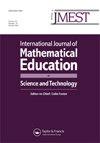Model, analyse and prevent fatal aircraft manoeuvres
IF 0.6
Q3 EDUCATION & EDUCATIONAL RESEARCH
International Journal of Mathematical Education in Science and Technology
Pub Date : 2023-09-20
DOI:10.1080/0020739x.2023.2249473
引用次数: 0
Abstract
AbstractOn 24 June 1994 at Fairchild Air Force Base, during practice for an air show, a low-flying B-52H aircraft banked its wings vertically and crashed. Emphasizing the activity of modeling drag and gravity, these notes examine the possibility of recovery with several models. First, with algebra, historical data lead to a model where in a free fall near Earth's surface, the distance fallen is proportional to time squared. Calculus then gives an ordinary differential equation to model free fall near Earth's surface. Second, with calculus, historical data lead to various models of drag on objects moving through air. Third, combining models of drag and gravity with Newton's Laws of Motion leads to ordinary differential equations that model free fall in air. Fourth, predictions from such models with ordinary differential equations are consistent with the aircraft crash. Further models examine the possibility of increasing engine thrust to regain the vertical component of lift. All models fit in a first course in differential equations, without requiring any computational machinery. However, numerical experiments show how uninformed use of professional software can produce rounding errors to cause the modelled aircraft to plunge to the bottom of the deepest oceans and shoot up into space.KEYWORDS: Accelerationderivativedraginitial conditionsintegralpositionvelocity AcknowledgmentsThis work was supported in part by a Professional Leave from Eastern Washington University.Disclosure statementNo potential conflict of interest was reported by the author.模拟,分析和防止致命的飞机操作
1994年6月24日,在仙童空军基地,一架低空飞行的B-52H飞机机翼垂直倾斜坠毁。这些说明强调了模拟阻力和重力的活动,用几个模型检查了恢复的可能性。首先,用代数,历史数据得出一个模型,在地球表面附近的自由落体中,下落的距离与时间的平方成正比。然后,微积分给出了一个常微分方程来模拟地球表面附近的自由落体。其次,通过微积分,历史数据可以得出物体在空气中运动时所受阻力的各种模型。第三,将阻力和重力模型与牛顿运动定律结合起来,可以得到模拟空气中自由落体的常微分方程。第四,这种常微分方程模型的预测与飞机失事是一致的。进一步的模型研究了增加发动机推力以恢复升力垂直分量的可能性。所有的模型都适用于微分方程的第一课,不需要任何计算机器。然而,数值实验表明,在不知情的情况下使用专业软件会产生舍入误差,导致模型飞机坠入最深的海洋底部,然后射向太空。关键字:加速度、导数、初始条件、积分、位置、速度致谢本工作得到了东华盛顿大学专业休假的部分支持。披露声明作者未报告潜在的利益冲突。
本文章由计算机程序翻译,如有差异,请以英文原文为准。
求助全文
约1分钟内获得全文
求助全文
来源期刊

International Journal of Mathematical Education in Science and Technology
EDUCATION & EDUCATIONAL RESEARCH-
CiteScore
3.30
自引率
11.10%
发文量
123
期刊介绍:
Mathematics is pervading every study and technique in our modern world, bringing ever more sharply into focus the responsibilities laid upon those whose task it is to teach it. Most prominent among these is the difficulty of presenting an interdisciplinary approach so that one professional group may benefit from the experience of others. The International Journal of Mathematical Education in Science and Technology provides a medium by which a wide range of experience in mathematical education can be presented, assimilated and eventually adapted to everyday needs in schools, colleges, polytechnics, universities, industry and commerce. Contributions will be welcomed from lecturers, teachers and users of mathematics at all levels on the contents of syllabuses and methods of presentation.
 求助内容:
求助内容: 应助结果提醒方式:
应助结果提醒方式:


